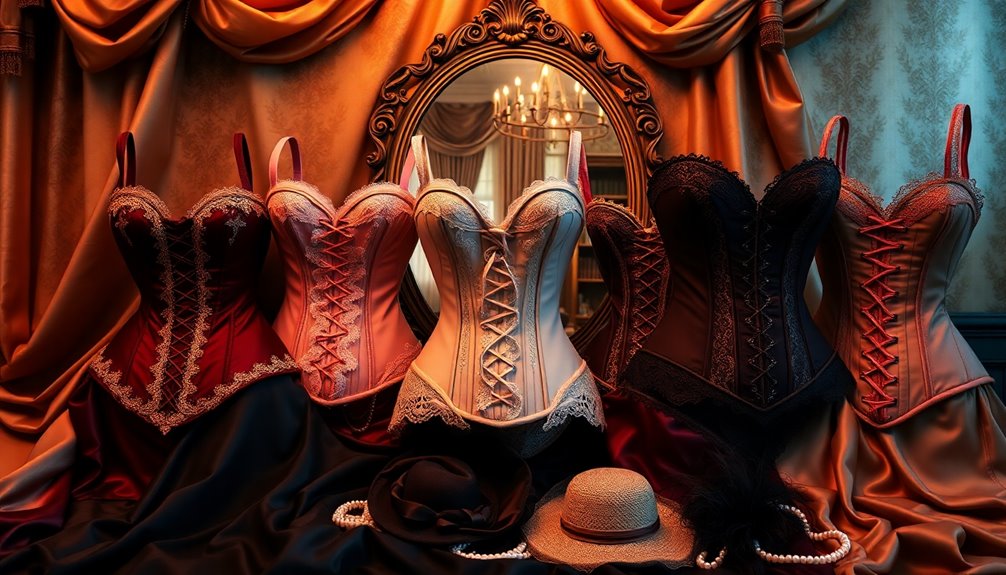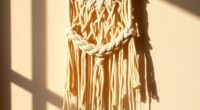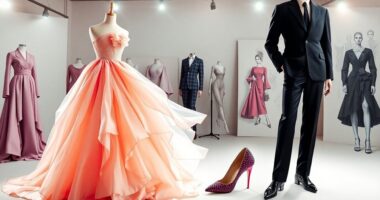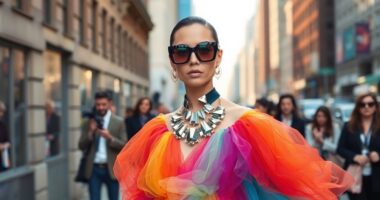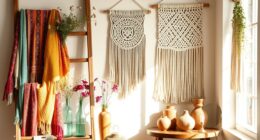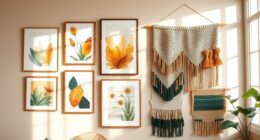Corsets have evolved from binding undergarments to stylish couture pieces, blending fashion with comfort. Today’s corsets celebrate cultural significance and empowerment, accentuating your silhouette with retro flair. Designers embrace this revival, creating contemporary styles that allow for movement and ease of wear. As you explore the fashion landscape, you’ll see how these garments reflect broader trends, like boho chic and athleisure, shaping your wardrobe choices. There’s much more to discover about this fascinating evolution.
Key Takeaways
- Corsets have evolved from restrictive undergarments to fashionable statement pieces, emphasizing comfort and cultural empowerment in women’s fashion.
- Contemporary corset designs are often featured in runway collections, reflecting a blend of retro aesthetics and modern wearability.
- The boho chic trend showcases relaxed silhouettes, pairing corsets with maxi skirts and eclectic prints for a stylish yet comfortable look.
- Athleisure influences have transformed traditional athletic wear, allowing corsets to be styled within versatile and chic outfits suitable for various occasions.
- Sustainable fashion practices are increasingly integrated into corset designs, utilizing eco-friendly materials while maintaining bold color palettes and contemporary styles.
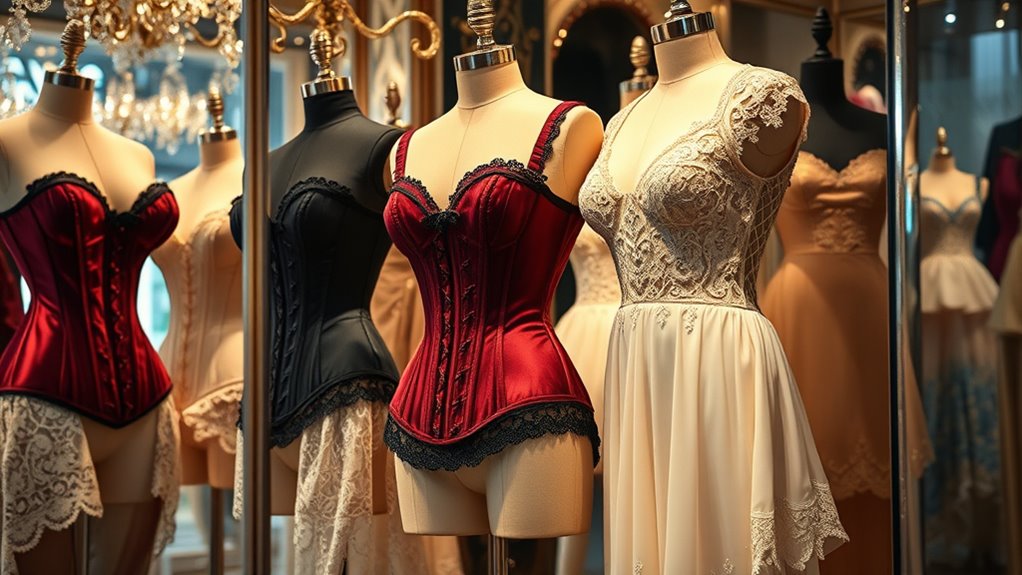
Women’s fashion is evolving, blending historical influences with modern trends to create enchanting styles. One significant revival in today’s fashion is the corset, which has changed from a restrictive undergarment to a fashionable statement piece. You’ll notice how contemporary corsets are designed for comfort and flexibility, allowing you to embrace retro aesthetics without sacrificing ease.
Designers often incorporate corsets in their collections, showcasing their dramatic flair on runways. This evolution reflects both the cultural significance and empowerment associated with corsets throughout history.
As you navigate the current trends, you’ll see the rise of boho chic, characterized by streamlined designs and a focus on maxi skirts and fringed outerwear. This trend marries eclectic looks with comfortable silhouettes, moving away from the rigid structures of the past.
Loose-fitting pants are now favored over skinny styles, allowing for a more relaxed and effortless vibe. The bohemian aesthetic also encourages you to explore vibrant animal prints, with cow, lynx, and zebra patterns becoming increasingly popular. These prints add a touch of wild elegance to your wardrobe.
Athleisure remains a staple in modern fashion, blending sportswear influences with elevated fabrics. You’ll love how cashmere and silk transform traditional athletic wear into chic, comfortable outfits perfect for any occasion.
Meanwhile, footwear trends are shifting as well, with loafers, boat shoes, and retro sneakers making their mark. You might find that Mary Janes, often adorned with multiple thin straps, add a playful touch to your ensemble. Boho clogs with wooden soles also inject a fun element, perfect for your casual outings.
When it comes to colors and fabrics, the 2025 palette is bursting with life. Shades of yellow and aquatic blues inspire your wardrobe choices, while turquoise is set to gain popularity.
Semi-sheer materials are trending, adding a contemporary twist to classic silhouettes. Metal hues capture the edgy and aquatic themes, allowing you to express your style boldly. Additionally, the growth of the beauty industry reflects the increasing emphasis on personal grooming and self-expression, influencing fashion trends significantly.
In the pursuit of sustainability, many fashion brands are embracing eco-friendly fabrics and recycled materials. You might find joy in second-hand shopping, a trend championed by Gen Z that promotes vintage finds while reducing waste.
As you curate your wardrobe, remember that women’s fashion isn’t just about aesthetics; it’s a reflection of personal values and the evolving landscape of style.
Frequently Asked Questions
How Have Corsets Influenced Modern Women’S Fashion Trends?
Corsets have greatly influenced modern women’s fashion trends by blending historical elegance with contemporary styles.
You can see them in various outfits, from casual streetwear to high-fashion collections. This resurgence allows you to express empowerment and individuality, as corsets challenge traditional beauty norms.
With celebrities and influencers showcasing them on social media, you’re likely to find corsets as versatile statement pieces in your wardrobe, reflecting a fresh take on femininity and style.
What Materials Are Commonly Used in High-End Couture?
In high-end couture, you’ll often find luxurious materials like silk, cotton, and wool, each offering unique qualities.
Silk provides a timeless feel, while high-quality cotton guarantees durability and comfort. You might also see leather for its versatility and velvet for an opulent touch.
Innovative fabrics like 3D printed textiles and hologram effects are emerging, too, allowing designers to create stunning, one-of-a-kind pieces that showcase both craftsmanship and creativity in fashion.
How Do Cultural Factors Shape Women’S Fashion Across Different Regions?
Cultural factors greatly shape women’s fashion across different regions. You’ll notice that traditional garments, like sarees or hanboks, reflect local values and history.
Social movements also influence trends, pushing for inclusivity and body positivity. As you explore various cultures, you’ll see how local materials and patterns tell unique stories.
Ultimately, fashion becomes a canvas for self-expression and cultural identity, allowing you to connect with diverse traditions and embrace their meanings.
What Role Do Fashion Icons Play in Shaping Women’S Fashion?
Fashion icons are like beacons, guiding you through the ever-changing landscape of style. They shape women’s fashion by challenging norms, introducing bold trends, and inspiring individuality.
When you see someone like Rihanna rocking baggy jeans or Princess Diana’s timeless elegance, you’re witnessing the power of influence. These icons empower you to express yourself, encouraging creativity and confidence in your wardrobe choices while leaving a lasting mark on cultural attitudes towards fashion.
How Can One Differentiate Between Couture and Ready-To-Wear Clothing?
To differentiate between couture and ready-to-wear clothing, consider the production process and personalization.
Couture pieces are handmade, custom-fitted, and often take hundreds of hours to create, making them exclusive and expensive.
In contrast, ready-to-wear garments are mass-produced in standard sizes, available off the rack, and designed for a broader audience.
While couture targets high-end consumers, ready-to-wear appeals to a diverse range of tastes and budgets, offering more accessible fashion options.
Conclusion
As you explore the evolution of women’s fashion, from the constricting corsets of the past to the liberating designs of modern couture, you’ll see how style reflects society’s changing attitudes. Just like a butterfly emerging from its cocoon, fashion has transformed, empowering women to express their individuality. Each era tells a story, reminding us that what you wear can be as significant as who you are. Embrace the journey, and let your style soar!

